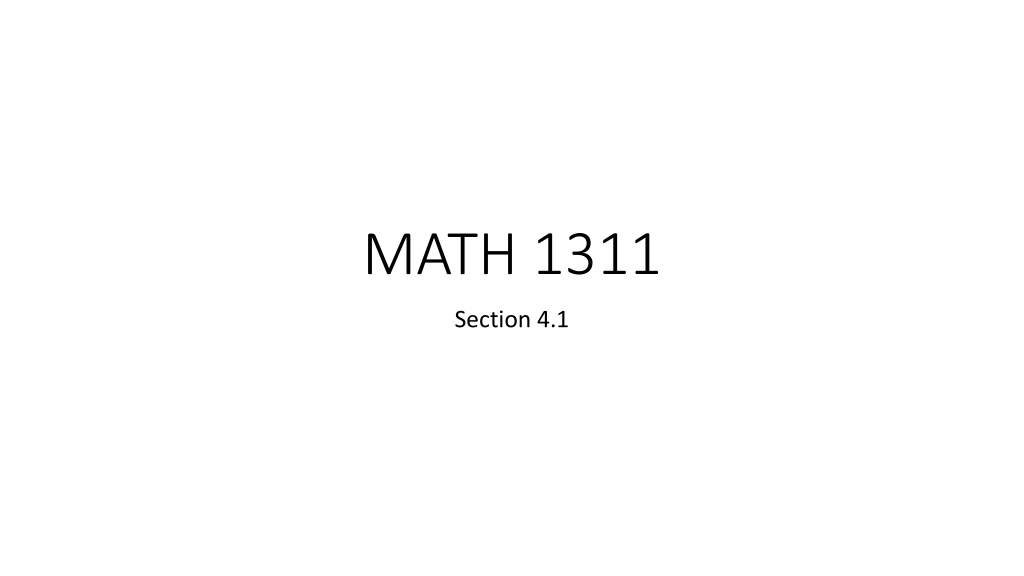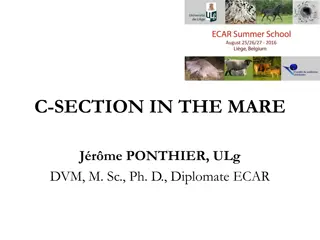
Understanding Exponential Growth and Decay in Mathematics
Explore the concepts of exponential growth and decay in mathematics, where functions involve multiplying by a predictable factor to obtain different coordinate points. Learn how exponential growth occurs when a value increases by a multiplier, such as the doubling of bacteria in a petri dish. Discover exponential decay, where values decrease at a predictable rate, like in radioactive elements with a half-life. Dive into creating formulas for these situations and understanding the properties of exponential functions through graphs.
Uploaded on | 0 Views
Download Presentation

Please find below an Image/Link to download the presentation.
The content on the website is provided AS IS for your information and personal use only. It may not be sold, licensed, or shared on other websites without obtaining consent from the author. If you encounter any issues during the download, it is possible that the publisher has removed the file from their server.
You are allowed to download the files provided on this website for personal or commercial use, subject to the condition that they are used lawfully. All files are the property of their respective owners.
The content on the website is provided AS IS for your information and personal use only. It may not be sold, licensed, or shared on other websites without obtaining consent from the author.
E N D
Presentation Transcript
MATH 1311 Section 4.1
Exponential Growth and Decay As we saw in the previous chapter, functions are linear if adding or subtracting the same value will get you to different coordinate points. Exponential functions involve multiplying the same value repeated times to obtain different coordinate points.
Exponential Growth Exponential Growth occurs when a value is increasing by a predictable multiplier. For example, the number of bacteria grown in a petri dish doubles every hour from an initial count of 3000 cells.
Exponential Growth Try to create a formula for this situation. Keep in mind, you are using repeated multiplications. We will use N(t) as the number of bacteria cells and t to represent the time in hours.
Exponential Growth Try to create a formula for this situation. Keep in mind, you are using repeated multiplications. We will use N(t) as the number of bacteria cells and t to represent the time in hours. N(t)=3000x2t Identify the initial value and the multiplier (known as the base).
Exponential Decay: Exponential Decay occurs when the base is a number between 0 and 1. For example, in chemistry, radioactive decay is the when a radioactive element becomes stable. This happens at a predicable rate, known as a half-life. If you have a 1000 grams of a certain radioactive isotope with a half-life of 1 year, create a table of the remaining amount of this substance for the first 5 years. Then create a formula.
Exponential Decay: If you have a 1000 grams of a certain radioactive isotope with a half-life of 1 year, create a table of the remaining amount of this substance for the first 5 years. Then create a formula. Time (years) Amount of Substance (Grams) 0 1 2 3 4 5
The population growth of a city is exponential. Currently the city has 30,000 people. It is estimated that it will increase in population by 5% annually. Determine a growth equation and find the population in 5 years.
The population growth of a city is exponential. Currently the city has 30,000 people. It is estimated that it will increase in population by 5% annually. Determine a growth equation and find the population in 5 years. Create a table and a graph of this function.
Popper 21: The number of trees in a certain forest is decreasing at an exponential rate. The forest currently has 25,000 trees. By next year, it is expected to have 20,000 trees. 1. Is this exponential growth or decay? a. Growth b. Decay 2. What is the initial value? a. 25000 b. 20000 c. 15000 d. 30000 3. What is the growth/decay factor? a. 5000 b. 1.2 c. 0.8 d. -1.2 4. What is the exponential function? a. n(t) = 20000 x5000t c. n(t) = 25000 0.8t b. n(t) = 25000 x0.8t d. n(t) = 25000 x-1.2t
Popper 21continued Complete the Table: Year (t) Number of Trees (N) 0 25000 a. 18000 b. 16000 c. 12800 d. 10240 1 20000 2 Question 5 3 Question 6 4 Question 7
Unit Conversion for Growth Factors: Sometimes it is convenient to convert the growth or decay factor to a standard unit (such as 2 or ) and have the non-integer value as the exponent. For example: The half-life of plutonium is 81 million years. This means that if we have an initial value of 10000 grams, the table would look like: Number of Half Lives Amount (grams) Time (Millions of Years) Amount (grams) 0 10000 0 10000 1 5000 81 5000 2 2500 162 2500 3 1250 243 1250 4 625 324 625
How to convert: Since it takes 81 million years to cut the initial value in half, rather than counting by number of half-lives, we can convert the exponent: n(h) = 10000 x( )h m(t) = 10000 x( )t Where t is measured in millions of years, rather than number of half- lives. When doing this, t = years/(half life).
Try it out: It is estimated that the alligators in a certain swamp will double every 15 years. Currently, the swamp has 250 alligators in it. What is the initial value? What is the base value? What is the exponent? Create the exponential formula.
Try it out: It is estimated that the alligators in a certain swamp will double every 15 years. Currently, the swamp has 250 alligators in it. Determine how many alligators are present after 10 years. Round to the nearest whole number.
Try this: It is estimated that the number of bacteria in a sample (after administration of antibiotic) will decrease by 1/100 every minute. You want to create a function to show how it will decrease by the hour. The initial sample has 15000 bacteria cells. What is the initial value? What is the base value? What is the exponent? What is the exponential function?
Verify with tables: This table shows the decay in terms of minutes. This table shows the decay in terms of hours.
Popper 21, continued: A sapling will grow new leaves at an exponential rate. It begins with 2 leaves, and that number is expected to triple every 6 weeks. You want to create a function that will explain the growth rate of the leaves in terms of single weeks. 8. What is the initial value? a. 2 b. 3 c. 6 9. What is the base value? a. 2 b. 3 c. 6 10. What is the exponent? a. t b. 6t c. t/6 11. What is the exponential formula? a. n(t) = 2 x 3t/6 b. n(t) = 3 x 26t c. n(t) = 2 x 36t d. 12 d. 12 d. -6t d. n(t) = -2 x 3t/6
Popper 21, concluded: A sapling will grow new leaves at an exponential rate. It begins with 2 leaves, and that number is expected to triple every 6 weeks. You want to create a function that will explain the growth rate of the leaves in terms of single weeks. 12. What is the number of leaves after 6 weeks (using formula)? a. 2 b. 3 c. 6 13. What is the number of leaves in 12 weeks (using formula)? a. 3. b. 12 c. 18 14. Do your answers for #5 and #6 confirm the accuracy of your formula? a. yes b. no d. 12 d. 24





















